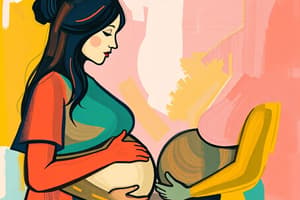Podcast
Questions and Answers
What is an effective strategy to relieve breast engorgement for a patient who is not breastfeeding?
What is an effective strategy to relieve breast engorgement for a patient who is not breastfeeding?
- Frequent nipple stimulation to express milk
- Warm compresses for 20 minutes several times a day
- Use of a supportive bra and ice packs (correct)
- Taking hormonal medications to reduce milk production
What is the expected location of the uterine fundus after delivery?
What is the expected location of the uterine fundus after delivery?
- Just above the umbilicus and firm
- Low in the pelvis and soft
- Firm and midline between the symphysis pubis and umbilicus (correct)
- Prolapsed into the vaginal canal
Which intervention should a nurse take if the uterus is not involuting as expected?
Which intervention should a nurse take if the uterus is not involuting as expected?
- Assess for signs of infection and report findings (correct)
- Immediately begin antibiotic treatment
- Administer pain medication without assessment
- Encourage the patient to increase fluid intake
How frequently should breastfeeding occur to prevent engorgement?
How frequently should breastfeeding occur to prevent engorgement?
Which phase of postpartum adjustment is characterized by the mother focusing on her own needs and feeling dependent?
Which phase of postpartum adjustment is characterized by the mother focusing on her own needs and feeling dependent?
What should a nurse assess in a patient regarding her knowledge of breastfeeding?
What should a nurse assess in a patient regarding her knowledge of breastfeeding?
What is a key nursing intervention when caring for a mother who may be at risk for postpartum depression?
What is a key nursing intervention when caring for a mother who may be at risk for postpartum depression?
What is an important aspect of the letting-go phase for new parents?
What is an important aspect of the letting-go phase for new parents?
During which phase does the mother begin to initiate care of her baby and seek more independence?
During which phase does the mother begin to initiate care of her baby and seek more independence?
Which intervention is crucial for postpartum women susceptible to Rubella before discharge?
Which intervention is crucial for postpartum women susceptible to Rubella before discharge?
What is an effective method to promote bonding during the taking-in phase?
What is an effective method to promote bonding during the taking-in phase?
How should the nursing staff support a new mother in managing breast care postpartum?
How should the nursing staff support a new mother in managing breast care postpartum?
In postpartum nursing care for a woman relinquishing her infant for adoption, what is a priority assessment?
In postpartum nursing care for a woman relinquishing her infant for adoption, what is a priority assessment?
What emotional response may older siblings display towards a newborn?
What emotional response may older siblings display towards a newborn?
What is a common symptom postpartum women should be advised to follow up on?
What is a common symptom postpartum women should be advised to follow up on?
Flashcards
Postpartum blues
Postpartum blues
Temporary, mild feelings of sadness, anxiety, or irritability after childbirth.
Postpartum depression (PPD)
Postpartum depression (PPD)
More serious mood disorder after childbirth, often lasting longer, requiring professional help.
Letting-Go Phase
Letting-Go Phase
Adjustment period following childbirth, where parents learn to balance independence with the needs of the newborn.
Engrossment
Engrossment
Signup and view all the flashcards
Preparation for Discharge
Preparation for Discharge
Signup and view all the flashcards
Taking-in Phase
Taking-in Phase
Signup and view all the flashcards
Postpartum Depression Risk
Postpartum Depression Risk
Signup and view all the flashcards
Bonding Process
Bonding Process
Signup and view all the flashcards
Taking-Hold Phase
Taking-Hold Phase
Signup and view all the flashcards
Postpartum Adjustments
Postpartum Adjustments
Signup and view all the flashcards
Breast Engorgement (non-nursing)
Breast Engorgement (non-nursing)
Signup and view all the flashcards
Postpartum Uterus Assessment
Postpartum Uterus Assessment
Signup and view all the flashcards
Postpartum Uterine Involution
Postpartum Uterine Involution
Signup and view all the flashcards
Bladder Assessment in Postpartum
Bladder Assessment in Postpartum
Signup and view all the flashcards
Nursing Interventions (Postpartum)
Nursing Interventions (Postpartum)
Signup and view all the flashcards
Study Notes
Postpartum Nursing Care
- Family dynamics become more complex with each child born
- Support family dynamics and include family in teaching and care
- Observe sibling interactions to identify potential problems and make referrals
Puerperium
- Period after childbirth, from placenta delivery until reproductive organs return to non-pregnant state
- Usually about 6 weeks, potentially longer with multiple pregnancies
Postpartum Physical Adaptations
- Body changes immediately after delivery
- Postpartum shivering has an unknown cause, possibly due to fetal/maternal blood mixing or amniotic fluid in the bloodstream
- Provide patients with warmth to alleviate shivering
- Reproductive system experiences substantial changes, primarily focused on uterus involution
- Oxytocin release causes uterine contractions to shrink the uterus
- Uterus size and weight decreases
- Fundus is firm at the umbilicus 1 hour after delivery and descends 1 cm daily
- 10 days post-delivery, the uterus may not be palpable.
- Afterpains (intermittent uterine contractions) may occur, often more noticeable in women who have had multiple children
- Lochia (vaginal discharge) may last up to 6 weeks, gradually decreasing in amount and color over time
- Cervix slowly closes, becoming barely dilated by 14 days post-delivery
- Vagina experiences diminished tone and swelling, but normal vaginal rugae (folds) should return in 4 weeks.
- Perineum may be bruised and edematous after delivery, Muscle tone should restore over 4-6 weeks
Ovaries and Ovulation
- Normal function after delivery is variable, potentially influenced by breastfeeding
- Menstruation may be delayed
Breasts
- Breasts secrete colostrum at first, then transition to mature milk
- Nipple stimulation triggers prolactin release to initiate milk production
- Engorgement (swelling) commonly occurs between the second and fourth day of postpartum
- Pain and tenderness may be present, but pain is not normal
- Interventions may be needed to suppress milk production if breastfeeding is not desired
Integumentary System
- Stretch marks may persist after delivery
- Linea nigra (line along the abdomen) may fade but may not fully disappear
Gastrointestinal System
- Increased hunger and thirst are common post-delivery
- Sluggish bowel movements and constipation may occur due to decreased movement and progesterone and anesthesia, stool softener or other treatments might be necessary.
Cardiovascular System
- Blood loss varies (250-500 mL vaginal birth, 800-1000 mL C-section)
- Cardiac output increases after delivery
Removal of excess fluid
- Diuresis: increased urine output (up to 3000 mL/day)
- Diaphoresis (sweating) is a means to remove excess fluid
Respiratory System
- Diaphragm returns to its normal position
- Respiration rate returns to pre-pregnancy levels
- Nasal congestion decreases
Urinary System
- Bladder tone decreases
- Bladder distension can obstruct uterine involution/lead to hemorrhage
- Urinary problem is often reported and monitored
- Encourage fluids to support excretion of excess fluid
- Monitor output
Musculoskeletal System
- Relaxin levels decrease
- Hip pain may persist
- Diastasis recti (separation of abdominal muscles) can occur and may involve surgery.
- Should be assessed and treated by healthcare provider as needed
Nursing Care During Early Postpartum Period
- Immediate postpartum care: typically in the hospital for 1-2 days (vaginal birth) or 3-4 days (C-section)
- Nurses provide physical care, monitor for complications and teach self-care
Uterine Assessment
- Palpate fundus to assess location and consistency
- Assess for tone
- Never palpate without supporting the lower uterine segment
Lochia Assessment
- Inspect amount and character to observe for complications
- Assess amount and color of lochia postpartum
Nursing Care During First Hour Post Delivery
- Vital signs monitored at regular intervals (every 15 minutes)
- Palpating the uterus is performed every 15 minutes
- Assess uterine tone, amount of vaginal bleeding, and condition of lochia
- Most crucial hour to identify and address potential postpartum complications
- Check for vital changes and other conditions like hemorrhage
Breast Assessment
- Assess for breast engorgement and nipple and breast pain
- Icepacks or supportive bras can help lessen the pain, discomfort and help with engorgement if not breastfeeding
- Teach mothers about supportive bra, ice-packs and analgesics.
Nursing Care for Women Who Relinquish Infants for Adoption
- Assessing emotional and psychological considerations
- Supporting patient decisions
- Including the mother's partner in the process
Development of Family Attachment
- Partner involvement is encouraged from prenatal and throughout the labor and delivery process
- Fostering sibling bonding, possibly requires strategies to establish and maintain a positive and healthy relationship among siblings.
Preparation for Discharge
- Self-care instructions, including perineal care, analgesics (pain relief medication), and dietary recommendations are vital to enable a stable transition home
- Follow-up appointments are essential
- Symptoms requiring medical attention are documented and reported
Postpartum Depression
- Risk assessment to help prevent or identify and treat the condition
C-section
- Uterine assessment, incisions, medications
- Support for Post-Surgical Adjustments
- Post-op care to prevent complications and monitor the patients
- Monitor for complications, including: atelectasis, thrombosis, infections, and deep vein thrombosis.
Studying That Suits You
Use AI to generate personalized quizzes and flashcards to suit your learning preferences.




